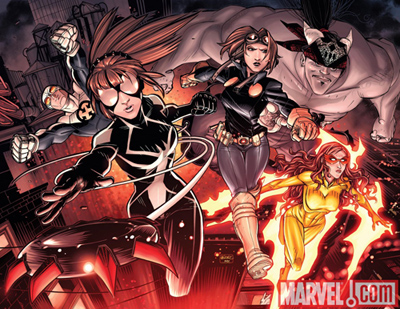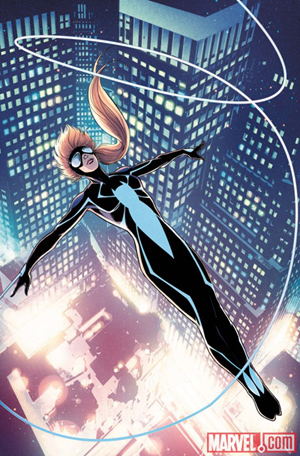Your Friendly Neighborhood Araña: The State of Latinidad in Marvel Comics
 In the sixth issue of Young Allies, a minor Marvel comic book, white teen superheroine Nomad expresses frustration with her inability to communicate with Benito Serrano, a.k.a. “Toro,” a fellow teenage superhero who is temporarily sharing her New York City apartment. Toro is a recent immigrant from Colombia, a former child soldier who wants nothing more than to help others, but the language barrier sets him apart from his primarily English-speaking teammates. Nomad is determined to help solve that problem, and by the end of the issue, a wordless panel depicts her proposed solution in the form of two language-learning books: “Inglés para principiantes” for Toro and “Spanish for Beginners” for herself.
In the sixth issue of Young Allies, a minor Marvel comic book, white teen superheroine Nomad expresses frustration with her inability to communicate with Benito Serrano, a.k.a. “Toro,” a fellow teenage superhero who is temporarily sharing her New York City apartment. Toro is a recent immigrant from Colombia, a former child soldier who wants nothing more than to help others, but the language barrier sets him apart from his primarily English-speaking teammates. Nomad is determined to help solve that problem, and by the end of the issue, a wordless panel depicts her proposed solution in the form of two language-learning books: “Inglés para principiantes” for Toro and “Spanish for Beginners” for herself.
This is a small moment, to be sure. Yet it’s indicative of a step forward on the part of Marvel Comics in its portrayal of issues facing Latinos in America. The standard superhero comic book “solution” to language differences has always been the deus ex machina, the telepath or electronic device that instantly teaches fluent English to the non-speaker. The character’s native language is thus eliminated entirely from the narrative, unless the plot calls for a trip to a foreign country. The scene in Young Allies differs significantly from this approach, not just in its portrayal of the actual difficulties of second language acquisition, but in its implicit presentation of English and Spanish as equally valuable languages, neither one privileged or eliminated.
Marvel Editor-in-Chief Joe Quesada, himself Cuban-American, has frequently downplayed the need to increase the number of non-white characters in comics. Despite his protestations, however, Marvel has quietly responded to the increased presence of Latinos in America with a corresponding, if tentative, increase in the number of Latino Marvel characters. At the forefront of this new wave of Latino superheroes is Humberto Lopez, or “Reptil,” a Chicano teenage boy who can turn into various dinosaurs. In his short tenure as a comic book character he has become the leader of a group of new superheroes in the comic Avengers Academy and serves the primary audience-identification role as the sole teenage character on the Marvel cartoon Super Hero Squad, a series targeted at the elementary school age group. Also prominent in current Marvel Comics are Gabriel Cohuelo, a Mexican teenager with speed powers and one of the five new mutant characters in Generation Hope, an X-Men spinoff, and Julio “Rictor” Richter of X-Factor, a Mexican immigrant who has appeared in Marvel comics since the 80s but who has received renewed attention of late for his newly-revealed bisexuality. Though Marvel has featured LGBT characters in the past, Rictor’s relationship with (white) boyfriend Shatterstar resulted last year in the first romantic, on-panel male/male kiss in Marvel history, and he is the only prominent queer male Latino superhero in comics.
For these characters, Latino culture has been pushed to the background to a greater or lesser degree. Reptil’s heritage is expressed almost exclusively through his name and appearance, Rictor’s Mexican background has rarely been addressed beyond an offhand utterance of “amigo” or “adios” since the 90s, and Gabriel (who has only appeared in two comic book issues at the time of this writing) is too new to evaluate. Young Allies, however, has over its six brief issues consistently negotiated Latino culture and the specific challenges of being Latino in America, not only through the character of Toro but through Anya Sofia Corazon, a Puerto-Rican teenage superheroine who formerly called herself Araña but is now known as Spider-Girl. Anya is bilingual (though English-dominant), and is the only character who can communicate effectively with Toro; though their conversations are translated for the benefit of the English-speaking reader, they’re shown to be speaking Spanish by indicative brackets, and their English speech is peppered with untranslated Spanish words both common (“gracias”) and culturally specific (“zángano”). They share a clear linguistic bond, but writer Sean McKeever is aware of the differences between various Latino cultures, as evidenced by Anya’s reply to a fire-based villain’s taunts that she must be missing “that Mexico heat”: “I’m Puerto Rican, dipstick!” The presence of two different Latino characters in an ensemble cast of five allows for a diversity of representation of Latino experiences uncommon in American media, as well as the rare chance for interaction between two non-white characters in an integrated narrative world, rather than between a non-white character and a white character.
Young Allies has sadly been cancelled as of October’s issue six, the result of poor sales. However, this Wednesday Marvel debuts a new Spider-Girl series by Paul Tobin and Clayton Henry, with Anya Corazon as its star. This marks the second solo series for Anya, whose Araña lasted only 12 issues in 2005. Unlike Araña, however, all signs point to a marketing push on Marvel’s part designed to make Spider-Girl a hit, including the character’s continued appearances in a Nomad-centric backup story in the high-selling Captain America and an official twitter account written from Anya’s perspective that actively responds to reader questions and will be featured within the text of the comic. Promotional interviews and solicits for the book have promised appearances from Nomad, which opens the possibility of Toro’s presence, and has encouraged hope from fans that Latino characters from her previous series (including her journalist father) may also make significant appearances. However, other signs indicate a potential focus on standard whitewashed definitions of “marketability” over cultural specificity – the cover of the first issue is colored in such a way that Anya appears to be blond and white, and the book’s very title ties the character more closely to Marvel’s white male cash cow, Spider-Man, than to Anya’s personal background, as the name “Araña” had.
Whatever the future may hold for Spider-Girl or any of these other characters, Marvel’s recent attempts at increased Latino representation are certainly worth noting, following, and analyzing by scholars, both of comic books and of racial diversity in media. Their audiences may be small, but in the increasingly multi-platform media landscape, the presence of Latino characters in comics (as is already the case with the TV version of Reptil) may ultimately shape and influence cartoons, merchandise, and blockbuster film franchises with a much wider cultural reach.






Marvel’s incorporation of Latino characters is especially interesting in contrast to DC’s current “back to the Bronze Age” approach, which has led to the death or marginalization of a number of non-caucasian characters in favor of their white male counterparts. This has led to some criticism, for instance:
http://www.comicsalliance.com/2010/05/06/the-racial-politics-of-regressive-storytelling/
Reading the fan boards, I see a conflict between fans calling for more diverse superheroes and those who reject new minority characters as mere tokenism. The hostility seems particularly virulent toward legacy characters who are replacing the “classic” versions of superheroes. But who knows whether that’s just typical fannish nostalgia or whether white male comic readers struggle to identify with minority characters. If it’s the latter, you’d think readers would then understand why broader representation is important — especially given comics’ shrinking readership.
But the fact remains that non-white male superheroes tend to sell poorly, sometimes leading to the deemphasis of their ethnicity, as you point out with Spider-Girl. It’s a complex issue — thanks for the post!
You’re very welcome! I’m actually working on a seminar paper right now on the exact topic you mention, inspired by Sims’ post, so I’m very aware of the issues at play there — and Marvel isn’t completely immune. But the presence of these characters does bring me some amount of hope, even if Spider-Girl may ultimately meet the fate of, say, the Jaime Reyes Blue Beetle.
[…] I wrote Your Friendly Neighborhood Araña: The State of Latinidad in Marvel Comics for Antenna, the blog run by my grad school department. The article discusses the recent higher […]
[…] Jennifer Margret Smith examines “the state of Latinidad” in Marvel-verse. [Antenna] […]
[…] films, and we have a comic book market where only two Marvel women (Spider-Girl, who I’ve complimented elsewhere, and X-23, teenage former prostitute clone of Wolverine) currently headlines an ongoing […]